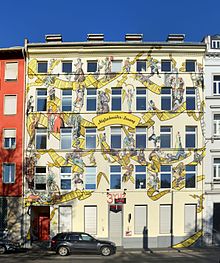Bespoke tailor
Tailors (Germany / Switzerland) and clothing designers (Austria) is a craft apprenticeship as a tailor in textile industry. In contrast to, for example, the industrial fashion tailors, bespoke tailors produce clothes individually "made to measure".
job profile
Bespoke tailors advise customers and produce items of clothing as required. You take measurements of the customer, draw the pattern and then manufacture the respective item of clothing. Depending on customer requirements, they use a variety of fabrics (cotton, silk, woolen fabrics, etc.). Some tailors also produce series products (assemblies). They also mend damaged clothing and make changes.
education
Germany
The training lasts three years in Germany and takes place in the dual training system at vocational schools and training companies. As an alternative, school-based training is also available. In the training, a distinction is made between the fields of ladies' tailors and men's tailors . Today there are two examination levels, the journeyman's examination and the master’s examination. With the latter one acquires the right to train apprentices.
In the past, men's tailoring had four training levels, in contrast to other skilled trades , which have three training levels, namely: apprentice with the qualification of journeyman examination , journeyman up to attending the cutting school with qualification as a tailor and tailor up to the master craftsman examination and subsequently master tailor .
In the GDR there were skilled workers training courses for women and men. The profession of ladies' tailor existed in the FRG from 1953 to 2004, in the meantime both have merged into the profession of bespoke tailor.
Austria
In Austria there were two separate apprenticeships until June 30, 2010, with the names of ladies 'clothes makers and men' s clothes makers . On July 1, 2010, a new training regulation came into force that also integrates other apprenticeships in a modular manner. This creates more professional flexibility within the textile industry. According to the Vocational Training Act (BAG), the training is called clothing design and is a modular apprenticeship . The training includes a two-year training in the basic clothing design module and a one-year training in one of the following main modules:
- Women's clothing (corresponds to bespoke tailor women)
- Men's clothing (corresponds to bespoke tailors for men)
- Linen production
- Milliner and hat maker
- Furrier and bag maker
In a further half year of training, apprentices can complete a second main module or one of the following special modules: clothing design, theater clothing, clothing technology. Accordingly, the training lasts three or three and a half years with an additional module.
At the end of the course, apprentices take the final apprenticeship examination and an additional examination for the special module. There are various master classes for advanced training. The master craftsman's examination facilitates independent professional practice (in one of the main modules), but is not mandatory. Many vocational schools offer very similar training courses that enable access to business.
literature
- Ruth Sprenger: The high art of men's clothing makers. Tradition and self-image of a master craft . Böhlau, Vienna / Cologne / Weimar 2009, ISBN 978-3-205-77757-1 .
Individual evidence
- ↑ Text of the ordinance on vocational training to become a bespoke tailor
- ↑ Federal Law Gazette II No. 191/2010 : current training regulation for clothing design of the Austrian Ministry of Economics, valid since August 2010
- ↑ Federal Law Gazette II No. 38/2003 : Entry requirements for the craft of the Austrian Ministry of Economic Affairs valid since 2003
Web links
- Tailors in Berufenet the Federal Employment Agency
- Men's tailor as a skilled worker training
- Women's tailor as a former profession
- Training and further education information on clothing design from the Institute for Economic Research: BerufsInformationsComputer (BIC)
- Professional and industry information about clothing design for trainers and apprentices of the Austrian Chamber of Commerce
- Short film about the apprenticeship as a bespoke tailor


